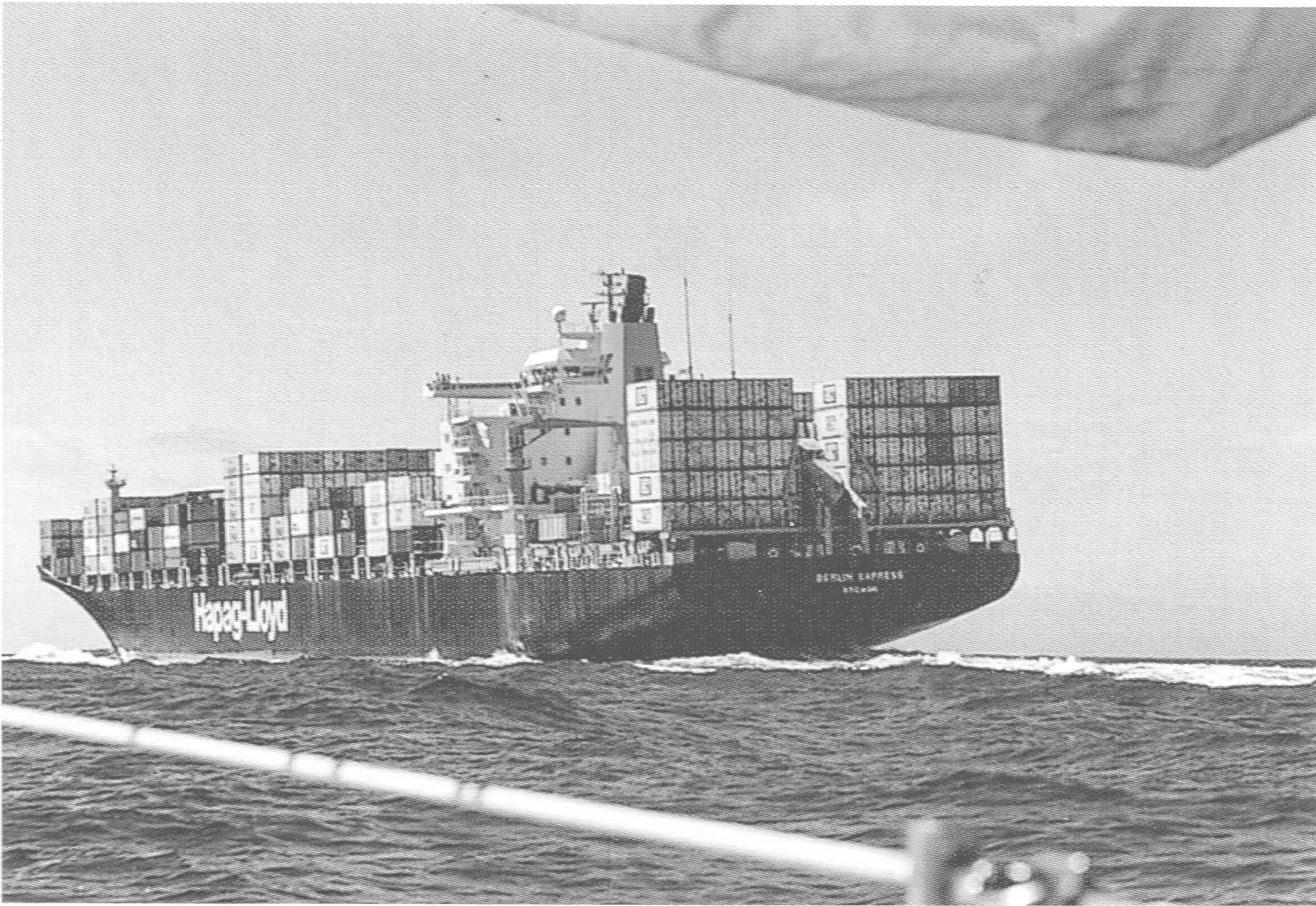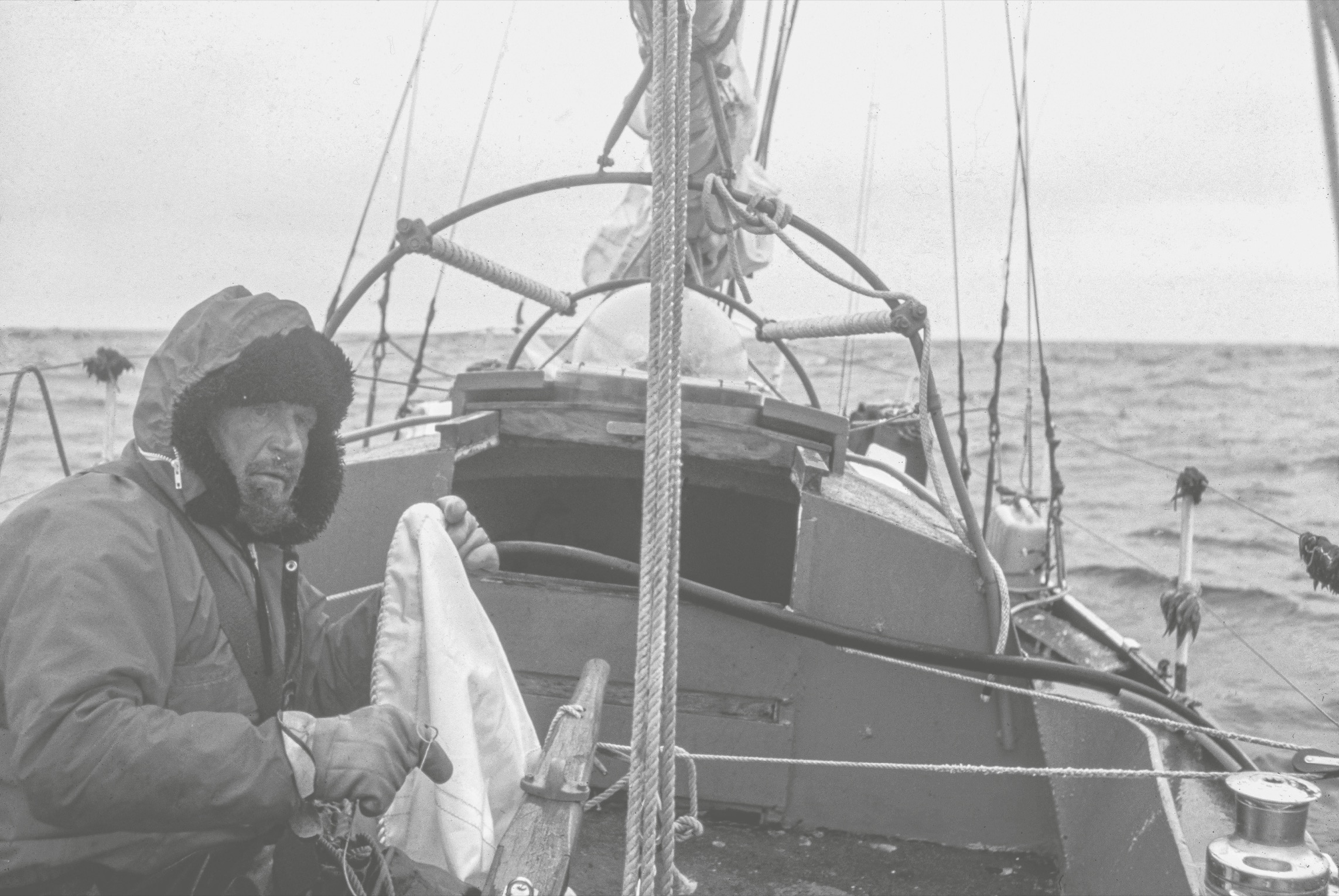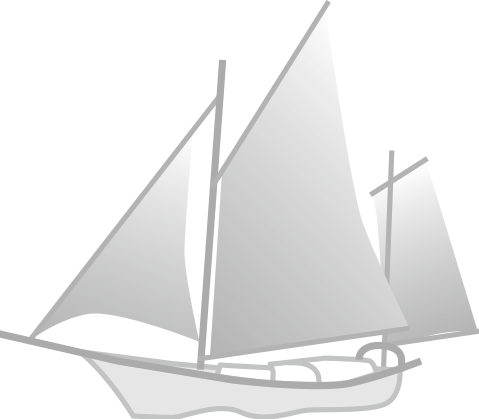22. Ships Again, Rescue
For the purposes of shameless foreshadowing, after Pinkney’s harrowing near miss and Petersen’s collisions, an additional aside on ship encounters is worthwhile here—as are a few further thoughts on the solo sailor’s risks and methods for rescue.
By the letter of the law, unless a merchant ship is restricted because of a narrow channel, the nature of its work, or it is in a shipping lane or some other navigational limitation, a sailboat, no matter how small, has the right of way—even if meeting a tanker twenty times its size. However, it is understood among reasonable mariners that small boats should not bother a merchant ship, but alter course themselves and stay out of a big ship’s way. In a few situations, though, it’s hard for a little boat to turn, and it just takes a touch with a joystick for the on-duty officer on a merchant ship to steer away for a few minutes with no impact on their schedule.
Seymour perhaps put the matter best in the 1980s: “I’m convinced that watch personnel aboard ships cannot see the tiny, low-range lights displayed by yachts until dangerously close. In addition, it is foolish to rely upon the detection of a little boat on shipboard radar. Therefore, it is mandatory for the solo sailor to accept responsibility for being seen and staying out of the way of everything that moves.” When he was sailing in areas with heavy ship traffic, Seymour used a high-powered strobe light, even though that’s not any kind of official navigation light and is technically illegal internationally.

The containership Berlin Express, the only ship Bill Pinkney saw during his 56-day passage from Cape Town to Tasmania (1991). The Berlin Express came up astern of Commitment and the two vessels snapped photographs of each other.
In the summer of 2022, Kenichi Horie, just before crossing the Pacific alone for the seventh time, told me that he rests easily with modern electronics. His boat has an Automatic Identification System (AIS), a technology required on merchant ships since 2004, but not available to small boats until a couple of years later. AIS pings on to an electronic chart plotter the exact name, course, speed of vessel, and the projected closest point of approach. Ship officers will presumably see the little boat on their computer screen and avoid it or make contact by radio if they cannot. Horie explained that he simply goes to bed when it’s dark and wakes up when it’s dawn, only getting up at night if there’s a shift in weather or something else that needs tending. With AIS he can also set an alarm, just like radar, if a vessel crosses a certain distance that you key in.
The statistics, the risks of encountering a ship out at sea, are difficult to calculate, because the danger increases significantly if traveling in known shipping lanes, approaches to ports, or closer to the coast. Fishing vessels normally congregate around known fishing grounds, but could transit from anywhere to get to them. With steadily increasing global trade, ships over time have been gradually growing larger and faster and with smaller and smaller crews. For example, the San Quirino, the British oil tanker that stopped to try to help Harry Pidgeon, only to crash into his boat, was a new vessel in the 1920s and was 415 feet long. Most of today’s ocean-crossing oil tankers are close to 1,000 feet long and are usually run by only twenty or so people on board.
It is also difficult to know how many solo sailors have died at the bow of a merchant ship or fishing boat, beginning in the modern era perhaps with Si Lawlor or likely Joshua Slocum. In 1968 the American boatbuilder and single-hander Arthur Piver sailed across the North Atlantic to participate in the OSTAR, but he was never seen again. In 1976 the English sailor Mike McMullen left the dock to sail solo across the Atlantic in the OSTAR race only days after his wife Lizzie was fatally electrocuted at the dock in an accident with a power tool that fell in the water. He was never seen again, and only a few pieces of his boat and a piece of sailcloth have been found washed up in Icelandic waters. In 1978, in another trans-Atlantic race, the French solo circumnavigator Alain Colas and his boat disappeared without a trace after a report of all’s well to the north of the Azores. In 2009 another experienced single-hander, Hubert Marcoux, disappeared off the eastern seaboard of the United States, heading southbound. Winds in excess of sixty knots might have been in his area. Were any or all of these sailors run down by a ship?
We only get accounts from the near misses, like Davison’s and Pinkney’s. For example, in 1964, after John Letcher sailed his little wooden boat alone from Hawai‘i to Alaska, he sailed along the coast of California where he found himself in light winds at night, directly in the shipping lanes. A ship bore directly down on him and didn’t respond to his searchlight. He had no engine. Letcher dived into the cabin at the last minute and the bow wave seemed to push off the boat enough so that he was not sunk, but the mast, rigging, and bowsprit were all torn to shreds as his boat rolled and scraped against the side of the large ship, similar to what had happened to Pidgeon and Moitessier when big ships got too close.
Before my trip I did a lot of reading and thinking about what I would do if Fox began to sink or catch on fire or if I had to abandon the boat for some other reason and needed rescue. As mentioned earlier, I purchased an EPIRB which would send out a signal that my boat was in danger if I clicked it on manually or if it was submerged under a given amount of water. I had a red neoprene survival suit. I had flares, a ditch bag, and a satellite phone in a waterproof case. Mostly because of space and expense, I chose not to purchase and try to mount an inflatable life raft on deck, using the rationalization that I was already in a small boat, so my job was to keep this one floating. I had a tiny inflatable row boat for getting to shore when I was anchored, but this was folded up on deck and would easily take twenty minutes, even when highly motivated, to get pumped up and ready to put over the side. In order to keep their sailboats afloat, some mariners have added extra flotation in all sorts of ways inside their cabins, while others have added watertight bulkheads so any flooding could be contained in one section of the hull.
The single-handed sailor “should have the decency to drown like a gentleman and not bother rescue people,” said Blondie Hasler, the veteran officer of the Royal Marines who founded the modern trans-Atlantic race in 1960. Written into the rules for this first race was that the sailors had to be ready to make their own repairs, and that they “have no right to expect or demand rescue operations to be launched on their behalf.”
This bravado is easier to support from the safety of shore, of course, and nobody knows how you will react in a moment of stress when your life is on the line. It is true, however, that rescue efforts can put other people in danger. In 1972, for example, seventy-year-old Sir Francis Chichester set out across the Atlantic for another go at the OSTAR. When he dropped radio contact for over a week, most presumed he was lost. It turned out he was indeed ill and his self-steering had broken, but he was heading for the Azores or maybe back home to England. Several misinterpreted communications followed while it seemed all of Europe tumbled out to rescue Sir Francis. The French weather ship France II got too close to Chichester’s boat and snapped some of his rigging and part of his mizzen mast. Then he really did need a rescue, which was conducted by a Royal Navy warship. On the way home, the France II then collided with an American private yacht in the Bay of Biscay, which the press reported (incorrectly) had also been outbound to rescue Chichester. “I had not asked for help,” Chichester wrote in The Sunday Times, devastated, before he knew the truth, “but that cannot alter the fact that those who lost their lives were trying to help me. They acted in the highest tradition of the sea, and I am deeply distressed that their generous action ended so disastrously.” The yacht had sunk, drowning seven of the eleven souls on board.
High-profile rescues of single-handers have continued to increase as the boats, designed for speed, have gotten lighter and faster, venturing farther, and solo sailors are pushing their boats harder and harder to win races. Although race officials have put in place more safety measures, including mandatory boat inspections and proof of at least one previous single-handed passage of a given number of offshore miles, there have been more than a few tragedies. In 2017, for example, even with all the weather routing and modern technologies, only seven of twenty-one entrants finished the OSTAR and four needed rescue due to an enormous and unusual storm in June. Among those rescued were experienced single-handers, veterans of other races and of severe conditions.
In the first BOC Challenge Race in 1982, seventeen sailors entered, ten finished all the way around the world with the four stops, and one person had to be rescued at sea. In the 1986 BOC Challenge, twenty-one sailors entered, sixteen made it all the way, one person had to be rescued at sea, and this time one person died. His name was Jacques de Roux, a former officer aboard French nuclear submarines. He was off the southeast of Australia. They recovered his boat, undamaged, but he was never found. In the previous BOC race, de Roux had capsized and lost his mast, but he had been miraculously saved by another single-handed sailor. This time, although in the lead, Jacques de Roux was exhausted, his self-steering hadn’t been working, and then something happened that we’ll never know. In the 1994 BOC round-the-world race, Frenchwoman Isabelle Autissier, who had successfully finished a previous circumnavigation race, this time lost her mast and after clinging to a damaged hull was airlifted by a helicopter launched from a frigate of the Australian navy. During the race that Neal Petersen completed in 1998–9, Autissier was leading the race but capsized in the distant Southern Ocean. She was rescued this second time by a fellow sailor (who went on to win the race).
As with Donald Crowhurst, Bas Jan Ader, and Jacques de Roux, occasionally a single-hander’s boat is found with no one on board. The cause of death here is presumably not a ship collision. In 1966 an experienced single-hander named John Pflieger, for example, still sailing well at sixty-eight years old, cleared out of Bermuda, but then his boat, without a soul on board and the jib set, tiller lashed, and a pipe still filled with tobacco, grounded on a sand bar off Antigua. Pflieger was never found. In 1968 one of the more famous of the single-handed ascetics, William Willis, who had traveled alone with practically nothing, on slow-moving sailing rafts across the South Pacific, died at age seventy-four while sailing by himself on a trans-Atlantic crossing out of Long Island, New York. A few days from Ireland, a Latvian fishing vessel found his boat with his logbook inside, but Willis had been long gone. In 1992, Mike Plant, a veteran of three solo circumnavigations, was crossing the Atlantic on the way to participate in the Vendée Globe, when he disappeared—a ship found his boat floating a month later, capsized, the keel broken off, about halfway between the Azores and Ireland. In 1997 a ship off the coast of Chile found the floating wreck of Vendée Globe racer Gerry Rouffs—he had been in second place. I could go on.
Just as Pidgeon and Moitessier bent steel or sawed off spars after collisions with merchant ships, and Bill King strung an old sail over the hole smashed in by a great white shark, a staple of single-handed sailor stories is the makeshift repair, in which our hero after a dangerous mishap must cobble together some fix in order to limp to port. For example, after heavy weather knocked over his mast, Robin Lee Graham had to use his boom as a mast and cut up existing sails to fit the makeshift rig as he managed to blow slowly over to the South African coast. Although Neal Petersen must also be in contention, I don’t think anyone suffered more often than David Lewis, who seemed to be constantly losing his masts. Lewis’ first book includes diagrams for a jury-rig he was forced to perform during his first trans-Atlantic crossing. Years later, after losing his mast in Antarctic waters during knockdowns aboard Ice Bird, Lewis required two different strategies to keep steerage and drift slowly along with extraordinary concoctions of bits of sail and pieces of spars and wire and an ice axe.
Today, to help those who are beyond a jury-rig, Coast Guard teams around the world have helicopters and aircraft on stand-by, with international agreements and protocols about range and jurisdiction for clear communication plans to rescue recreational sailors, as well as anyone else at sea who is in danger, such as ferry and cruise ship passengers and mariners on fishing vessels and merchant ships. These Coast Guard rescue teams will coordinate with any private, commercial, or naval vessel who might be traveling through the area, all of whom are duty bound by international custom to assist any seafarer in trouble.

David Lewis sailing alone to Antarctica aboard Ice Bird (c. 1972).
The thought of death for the single-hander—drowning, sinking, dying from fire or thirst or an infection or blood loss—all comes not only with one’s instinct for self-preservation, but the consideration of one’s potential death also comes with a significant element of guilt for those left on shore: family, friends, or a professional team supporting one’s voyage. In her narrative, circumnavigator Naomi James wrote about the contradiction of wanting to push herself beyond what she thought possible, for herself, but then also pangs of guilt over how her failure would hurt those who had encouraged, even enabled her trip. This included her new husband, Rob James, himself a highly experienced ocean sailor who knew well how little experience she really had: “They believe I can do it because I believe I can, and such a belief in a person’s determination is an incredible expression of faith. But if I fail, then, in the eyes of the world, they will be the ones to blame. And they won’t be able to exonerate themselves by saying she died because she made a mistake, even if it were the truth. Poor Rob. I’ll have to make it. It would be just too terrible if I didn’t.”
Dame Naomi James did make it back and all the way around the world. A few years later, Rob James drowned off the coast of England. He was not sailing alone, but he fell off the boat that he was racing. This was ten days before their daughter was born.
